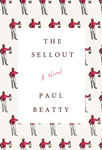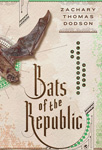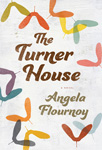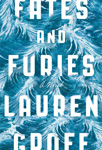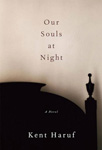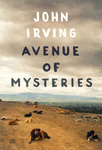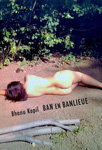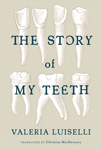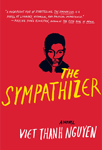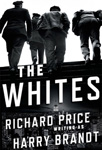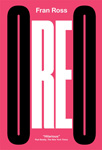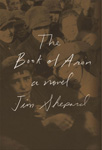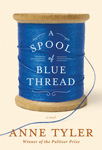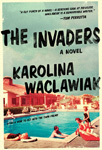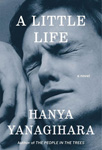by Chris Adrian and Eli Horowitz
Buy it at Powell’s »Blake Bailey: Like many discerning people (judging from the acclaim) my wife has read A Little Life, and when I began the book I remarked to her that the protagonist, Jude, seemed to be cutting himself an awful lot. “No way,” I said, when she revealed certain details about Jude’s lurid backstory, which transpires very gradually over 720 pages. “Oh c’mon!” At length my wife couldn’t resist acting out one of Jude’s grislier contretemps—the one that explains his trouble walking.
But then, I’d already decided the novel was an allegory of sorts, and thus the author was entitled to a little license with verisimilitude. The four main characters—friends from the same prestigious, unnamed Eastern university—are carefully multicultural and sexually ambiguous to a man: JB the artist is black, Malcolm the architect is biracial, Willem the actor is Nordic, and Jude the lawyer is in some indeterminate category and hence the most allegorical of all. (Even the author seems a little on the allegorical side. There’s no photo on the hardcover jacket, and the one-line bio at the end of the book informs us only that “Hanya Yanagihara lives in New York City,” as do eight or nine million others. New York City, by the way, is as ahistorically nondescript in the novel as Metropolis in Superman.) All four friends go on to be rich and famous, each after his own interesting fashion. Why not?
But the book is mostly about Jude, who I suppose is meant to remind us of Job, if Job were given to mutilating himself with razors while sitting on his ash heap forbearing to curse God and die. Indeed, Jude seems to be terribly hard on himself for such an otherwise meek person, and this despite being extravagantly loved by his friends—not only the three aforementioned, but his law mentor, Harold, who adopts him, and Andy, the doctor who treats his wounds for free and refrains from insisting he see a therapist as the years pass and the only unmutilated part of him (one imagines) are his eyeballs. And who can blame Harold, et al., for loving such a prodigiously gifted person? Never mind the wealthy lawyer part; Jude is also an accomplished singer of lieder, a pure mathematician of genius, and an expert baker—all this achieved against, as we shall see, pretty long odds.
Nobody seems indifferent to Jude; he’s either loved by sweet-natured friends or extravagantly abused by monsters, who are to Jude what the Acme Corporation was to Wile E. Coyote. After his unknown parents leave the infant Jude beside a trash bin in South Dakota, he is raised in a monastery by sadistic monks who give him a good education withal. Finally he escapes with the nicest monk—the nicest, mind—Brother Luke, who explains to the nine-year-old boy that he’s “going to do what you did with Father Gabriel and a couple of the brothers.” This so the two can afford a cabin in the woods and live happily ever after. “How many more until we get the cabin?” little Jude wanly inquires, having serviced a legion of brutal truckers and the like. Soon Jude begins throwing himself against walls, and Brother Luke complains—but gently—that his clients don’t like seeing him bruised; ghastly disfiguring scars are another matter, though, so Luke teaches him how to cut himself with razors. “He was so dependent on Luke: for his food, for his protection, and now for his razors.”
It gets worse. A few years later we find Jude imprisoned in the sticks by one Dr. Traylor, who rapes and tortures him. Finally Jude tries to escape by smacking his tormenter in the face with a paperback copy of Dubliners that he snatches from the doctor’s bookcase. I almost forgot to deplore his choice of weapon—for God’s sake, man, at least grab Ulysses or Finnegans Wake!—so bemused was I by the information that Dr. Traylor was a Joycean. In any case this is where Jude finally gets a break—waking up in a hospital and meeting a kindly social worker who recognizes his brilliance and encourages him to apply to college. “A year after Dr. Traylor, [Jude] was in the college he had dreamed of …” Again, why not? Job is restored to health and wealth, after all, and lives a long and happy life. But Yanagihara is not as gentle as the Old Testament Jehovah, and she’s not done with Jude.
Unless we count the ghost, or “haint,” that keeps appearing to some of the characters, and stands for any number of things (along with being, possibly, just a literal haint), The Turner House is decidedly non-allegorical. The African-American characters are neither saintly nor monstrous but vividly individualized human beings. Ditto the place and time: Detroit in all its sketchy, multifarious splendor, as it was during the Great Migration and a few generations later, in 2008, as the auto industry sinks and the Turner family’s garage is stolen overnight for scrap metal. The Turner house on Yarrow Street has been empty since the matriarch, Viola, suffered a stroke and had to move in with her eldest (of 13 children), Cha-Cha; it’s now worth maybe a tenth of its $40,000 mortgage, and is at the center of the family’s struggle to keep its hold on the lower rungs of the middle class. The characters’ blackness is certainly germane to this struggle, but otherwise rather incidental, and their joys and sorrows aren’t nearly so antipodal as those in A Little Life. “He’d looked into more established ‘hip’ neighborhoods in Midtown,” the author writes of a character who achieves a degree of success, “but they weren’t for him. He was too smart to pretend he was alright with being a token in a city with such a large black population, with walking into new restaurants where the all-white patrons looked at him with suspicion, as if his very presence suggested that they weren’t as close to ‘revitalizing’ the area as they’d hoped.”
Hardships take their toll on the Turners, young and old, in the form of addictions. The alcoholic patriarch, Francis, and his successor, Cha-Cha, are both beset by haints—the manifestation of an indefinable malaise, the awful burden of familial responsibility. Lelah, the youngest, takes to gambling as a way of escaping worry, her mind going blank as she moves chips around the table. Almost everyone in the novel behaves badly without losing our sympathy, and ultimately wins some measure of redemption. I’m hardly a sucker for happy endings (I wrote a biography of Richard Yates, after all), but, eliding the particulars, I like the happy-ish ending of A Turner House—a flashback to the day they moved into the big house on Yarrow: “[Viola] did a short, celebratory dance in the hallway upstairs. Francis lingered on the porch with little Francey in his arms. He smiled down at his daughter. He allowed himself to hope.”
As for A Little Life, well, I won’t spoil it for readers who persevere, and anyway the fun is in getting there. Suffice it to say that Willem and Jude discover their love for each other in middle age (though Willem was previously straight), and appear to be headed for a blissful sunset until the big Sophoclean finale. Garth Greenwell, writing in the Atlantic, embraces the book’s grotesqueries and even suggests that it may be “The Great Gay Novel”: “It engages with aesthetic modes long coded as queer: melodrama, sentimental fiction, grand opera.” I would venture to say that the pomp of grand opera is one thing, to be viewed with binoculars as it were, and the nuances of literary fiction another. Florid melodrama in the latter is usually called kitsch.
The Turner House by a mile.
Match Commentary
By Kevin Guilfoile & John Warner
John: By the end of Judge Bailey’s critique of A Little Life, I wanted to say, “Well, if you put it that way—” and disavow any of my previous praise, even as someone on the more skeptical end of the spectrum when it comes to the novel.
The case against the book, as Judge Bailey puts it, is persuasive. I’m sort of convinced that I was wrong for ever finding it compelling, that I allowed myself to be overwhelmed in a way that caused me to take leave of my faculties.
But the testimonies of the A Little Life fans are also pretty compelling evidence.
I don’t know what to think anymore. One thing I do know is that A Little Life isn’t going to win the Rooster, but we should be grateful for its presence in the tournament.
Kevin: This is an example where the ToB judgments and commentary have fundamentally changed my understanding of a novel. I don’t know that I necessarily like A Little Life more or less than I did, but this entire discussion has elevated my awareness of what is going on when people, collectively, read it.
In the opening round we had kind of an internecine conflict when ToB producer extraordinaire, Nozlee, waded into the comments specifically to take me to task for some things I had said about A Little Life in the commentary. Of course you and I had written those things almost a month earlier, so now I realize Nozlee had been quietly burning with rage at me all this time. (Love you Nozlee!)
But it’s clear to me now that there are a lot of people who have connected with this novel on an emotional level that is simply not available to me. That sounds condescending, and it’s not meant to be. It’s actually amazing. I don’t know how you would even attempt to write a novel that has that kind of effect on people.
I certainly felt emotions when reading A Little Life, sometimes powerfully, but those emotions were always tempered by questions from my intellectual reading brain, like “How did Jude ever get through law school?” Judge Bailey’s intellectual reading brain raised the same questions and came back with the answer, “Well why not?”—implying that these are questions Yanagihara is not concerned with at all. And he’s right.
But where Judge Bailey sees this as a problem the novel can’t overcome, other readers see these questions as being so far removed from the point that it angers them that you would even bring them up. Go back and read Nozlee’s wonderful description of the ways A Little Life spoke to her. The ways it expressed ideas and feelings that she had not seen articulated before outside of her own mind. It was incredible to read that, but at the same time, it’s not a part of the novel I can access. The difference now, though, is that I can listen to other people describe that experience and appreciate it vicariously. In this way, I guess my esteem for the novel (or at least the novel’s influence on people) has been upgraded, even if my own understanding of the text hasn’t fundamentally changed.
Before we leave this novel for good, I’d like to point to another discussion from A Little Life’s opening round comments (everyone should read that entire thread if they have time—it’s amazing). There was a particular discussion about fan fiction and the ways it might have inspired A Little Life. (I think it was started by readers capfox, Kristin-Leigh, and Caroline Pruett; I apologize if I’m withholding credit from others.) I don’t have anything to add to it (my experience with fanfic is limited) but I thought it was fascinating, and not at all condescending to either A Little Life or to the world of fan fiction. Even though it was focused on a narrow point, it was one of the most interesting things I’ve read about this book anywhere.
John: I’m curious if there’s a “director’s cut” of The Turner House, a bunch of chapters, or even entire story threads that were written, but ultimately not included in the final narrative. You could write a different novel about the Turners simply by choosing different focal characters.
Or what would happen if Flournoy got to rewrite the story from those different points of view 10 years from now?
I’m thinking of something like Evan S. Connell’s Mrs. Bridge and Mr. Bridge, which cover the lives of an upper-middle class married couple living in Kansas City between the World Wars. They cover similar territory to Richard Yates’s Revolutionary Road: the ennui of American suburban life. Connell wrote them a decade apart, but they cover the same time period from those different perspectives.
Imagine the effect of time on how we will view what’s happened to Detroit. Will the neighborhood of the Turner House be abandoned or resurrected (or something in between)? Will President (Ivanka) Trump be touting yet another plan to return the Rust Belt to prosperity?
This story isn’t over by a long shot, which was one of my chief pleasures and disappointments in The Turner House. The whole deal just feels sort of “provisional.” Even as this is true to life, as a reader it left me a touch unsatisfied.
Kevin: Isn’t that just the product of Flournoy’s world being so fully imagined? It is very easy to daydream about the rest of the book’s universe, about the thousands of other Detroit houses occupied by thousands of other people, all of them with fleshed-out backstories even though Flournoy never mentions them. On the other hand, you don’t feel like there are other people in A Little Life aside from the ones Yanagihara writes about. It’s more like a fairy tale. I mean, presumably there are more than just those seven dwarves living in the forest. Someone probably owns the mine they work in, and I bet he’s an interesting fellow, but we don’t read Snow White wondering if they’ll ever make a movie about him. I agree, I can’t get enough of the Turners. If she wants to come back to these characters (or their friends or neighbors or relatives or ancestors or descendants) I will pay summer prices for that ride.
We at least know that the Turners will be back for the Rooster finals. Tomorrow Fates and Furies returns to do battle with The Sellout in a match between my favorite novel of last year and very nearly my favorite novel of last year. ToB veteran and author of Everything I Never Told You Celeste Ng will get judgmental, with Katy Waldman, Dan Kois, and Laura Miller from Slate’s Audio Book Club sparking the discussion.
John, you and I will meet everyone back here for the finals!

The official 2016 Tournament of Books T-Shirt by book designer Janet Hansen. Order yours!



